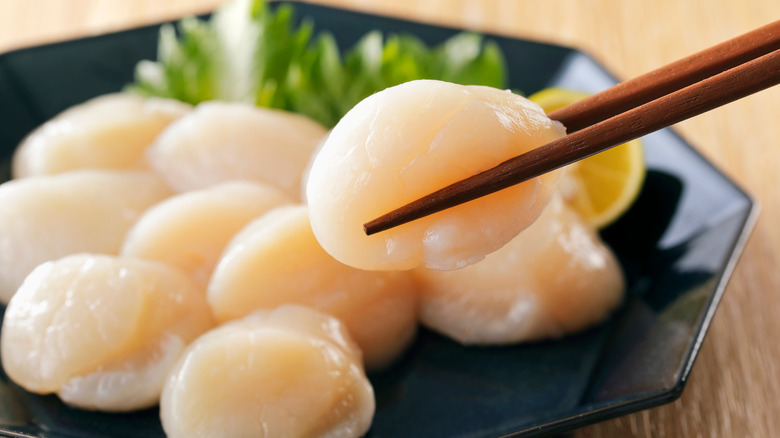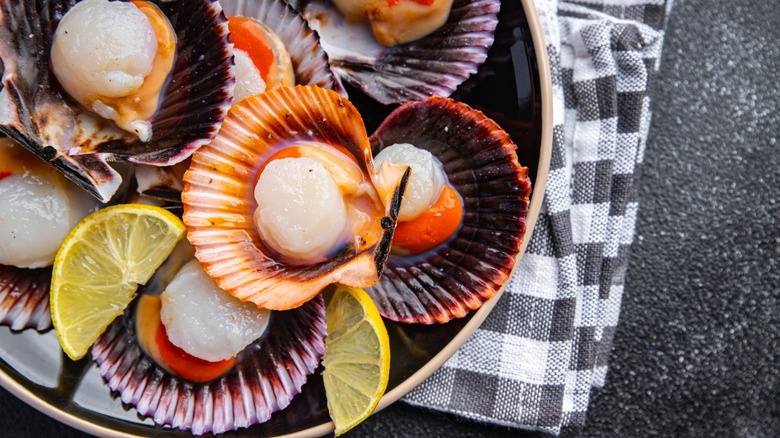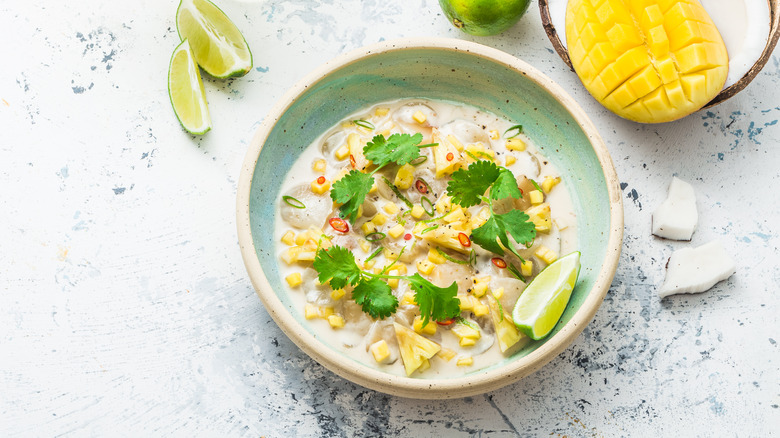Can You Eat Raw Scallops Without Getting Sick?
Cultures around the world are home to their own delicious raw seafood dishes, from crudo to carpaccio, ceviche, poke, sashimi, kinilaw, yusheng, tiradito, and more. Fish, shrimp, and roe are enjoyed uncooked in these preparations, but scallops aren't as widely-used. You may wonder if this is because raw scallops are unsafe to eat.
The simple answer is that raw scallops can be safe to eat (and absolutely divine), but as with any uncooked protein, quality and freshness determine whether you'll enjoy your dinner with no ill effects, or end up unsatisfied. When shopping for the best scallops to eat raw, look for the terms "day-boat" and "dry." Day-boat scallops are caught over the course of a single day and sold shortly thereafter, while scallops labeled as "dry" have not been stored in water or soaked in a preservative solution.
You also need to seek out a reputable fishmonger or restaurant with responsible sourcing to avoid getting sick. Live scallops need to be stored under very cold temperatures, or frozen immediately after harvesting. They also need to be fished from clean water, as they easily accumulate toxins, being filter feeders. Cases of bad scallops are common and worth researching. In January 2024, the Food and Drug Administration issued a recall for scallops from the Massachusetts coast due to contamination from "human pathogens" and "toxic elements". These were distributed by Intershell International Corp, which is believed to have bought them from an "unlicensed harvester" who "harvested from prohibited waters."
Why day-boat and dry scallops are better
A common method of gathering scallops is to fish for them over longer periods of time in large fishing vessels. As the shellfish are caught, they're stored on ice. That means that by the time the ship gets back to shore, some of those scallops may be around two weeks old — not including the time it takes to distribute them to your local grocery store.
Day-boat scallops are pretty much the opposite — they are fished from boats that just go out for a single day. The catch is brought back to shore, and then the scallops are available for sale shortly thereafter. Scallops with this label are guaranteed to be fresh. If you don't live on the coast, you can still get day-boat scallops. Retailers can flash-freeze them to preserve their quality, or ship fresh scallops overnight to your home.
Meanwhile, the difference between wet and dry scallops is in how they are stored for sale. Dry scallops are never stored directly on ice, because as the ice starts to melt, the scallops absorb the water, which dulls their natural sweetness. Some companies will soak their scallops in a preservative brine, which further affects the flavor and texture. Undoubtedly, seeking out dry and day-boat scallops will cost you a pretty penny, but the quality definitely justifies the cost, especially if you intend to eat them raw, with few other ingredients to disguise any faults.
Tips for preparing raw scallops
Visual and olfactory cues can also alert you to a good scallop. Scallops can range from cream-colored to pale orange or pink, but they should not have any discoloration or any liquid pooled underneath. For frozen scallops, ice around the scallops themselves is an indication that the package may have been damaged. As for the smell, scallops should have a light, sweet, and pleasant scent of the sea. Any funky, fishy, or pungent odors are a clear sign that they have gone bad.
For best results, fresh scallops should be eaten the same day you bought them, or stored in the refrigerator for no more than two days. Frozen scallops should be thawed in cold water or in the fridge overnight, and also consumed as soon as possible.
The beauty of scallops lies in their subtle sweetness and delicate brininess, which really shine in raw preparations. Choose similarly delicate ingredients to complement them, like mild olive oil, citrus zest or juice, and tender herbs. Scallops shine in simple nigiri sushi or thinly sliced for sashimi. They also have a buttery quality that can stand up to bolder flavors, as long as those flavors are used with balance and restraint. Consider pairing scallops with lime juice, soy sauce, ginger, radishes, stone fruit, tomatoes, or even a fresh chili pepper or two.



